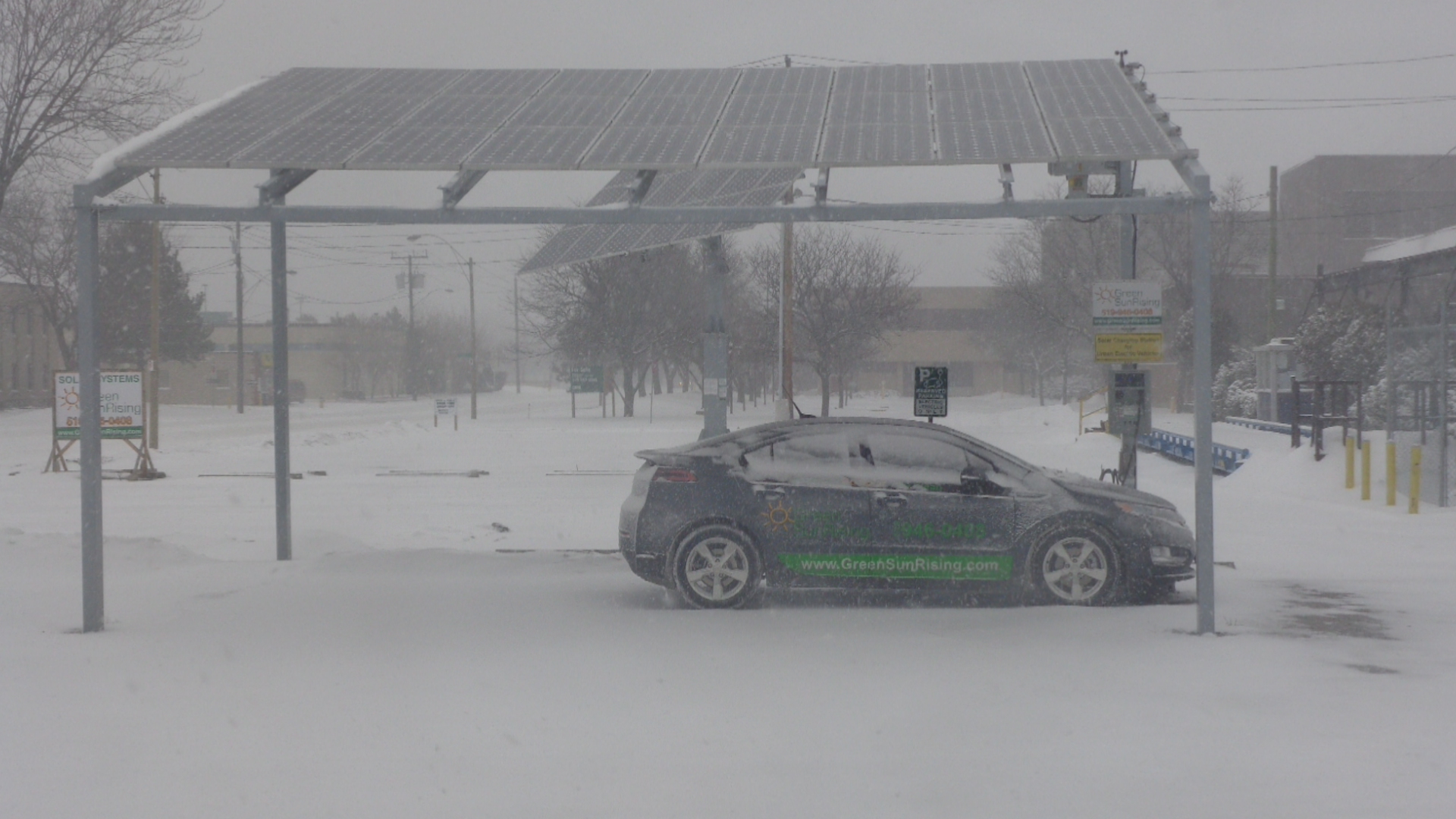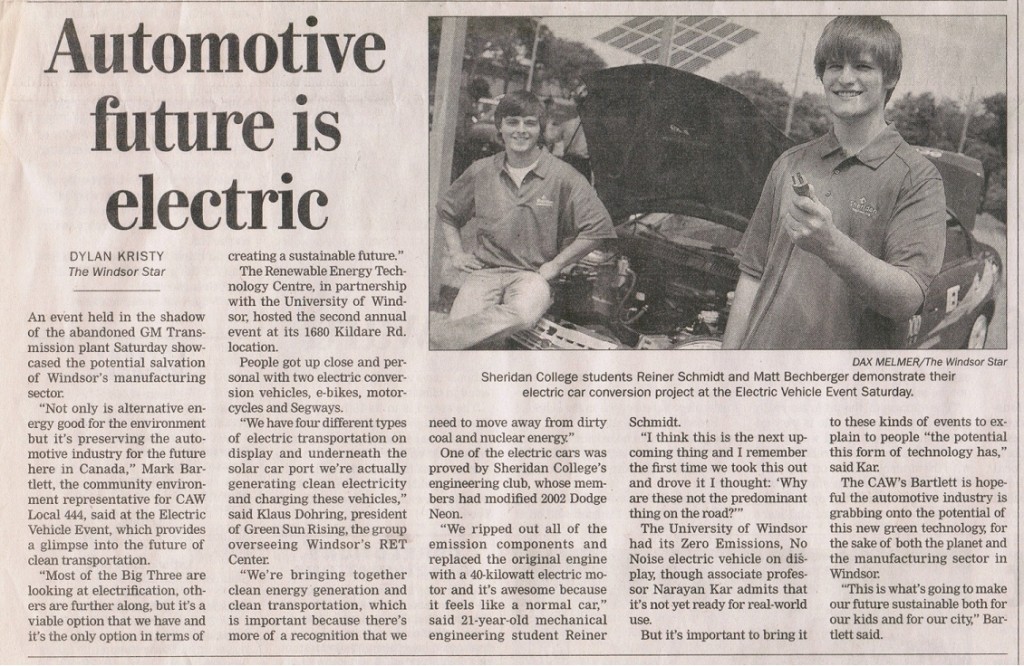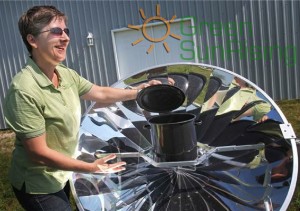————————————————————————————————————————-

Bet you bottom dollar that tomorrow there'll be sun! Our Green Sun Rising Solar Carports will protect your car even in a snowstorm.
————————————————————————————————————————-
————————————————————————————————————————-
See here Green Sun Risings latest Press Release
Green Sun Rising Goes North – Arctic Energy Alliance purchases five Solar Off-Grid-Demo-Systems
Windsor, Ontario – August 29, 2024 Green Sun Rising Inc.,Windsor’s longest operating renewable energy company, just signed an agreement with the Arctic Energy Alliance for the purchase of five mobile Solar Off-Grid-Demo Systems for theNorthwest Territories.
The Arctic Energy Alliance (AEA) is a not-for-profit society with a mandate to help communities, consumers, producers, regulators and policymakers to work together to reduce the costs and environmental impacts of energy and utility services.
The five solar systems will be locally manufactured in Green Sun Risings facilities inWindsorand then shipped toYellowknife, from where they will serve to demonstrate the functionality and advantages of solar systems all over theNorthwest Territories.
The systems are mobile and are equipped with modules, made in Ontario by Canadian Solar. They also utilize inverters, charge controllers and battery back-up systems. They are fully operational and suitable even for the harsh climate in the Northwest Territories.
Klaus Dohring, president of Green Sun Rising: “This shows how solar off-grid systems get more and more exposure all over Canada. Especially in remote areas like the Northwest Territories, solar systems are a great, affordable and effective way of providing electricity.”
Green Sun Rising Inc. is aWindsor,Ontariobased company focusing on developing and supplying solar systems, both solar PV for clean electricity, and solar thermal for clean heat energy.
Green Sun Rising also operates theRenewableEnergyTechnologyCenterin Windsor, a community-based institute for understanding sustainability and renewable energy. Here they showcase several solar demo systems and operate two electric vehicles with the necessary level 2 charging stations, supported by carports covered with solar panels.
For more information, please visit www.GreenSunRising.com or contact the company at [email protected].
Contact: Tanja Nuske, 519-946-0408
————————————————————————————————————————-
——————————————————————————————————————-
Article in the Windsor Star about Green Sun Rising's Solar Bench and Solar Bikeport being installed at the Devonshire Mall in Windsor, ON.
——————————————————————————————————————-
Green Sun Rising President Klaus Dohring and a team from SMA and Hydro Quebec celebrate the commissioning of a SMA 250kW Central Inverter
——————————————————————————————————————-
Green Sun Rising president Klaus Dohring comments on the spending cuts in the U.S. in a letter to the Windsor Star
——————————————————————————————————————-
——————————————————————————————————————-
First prize for Green Sun Rising's Solar Bench: Mechanical Designer Patrick Marion and Electric Designer Hassan Beydoun present their award for "Experimental Development – New Product". The prize was awarded as part of the Innovation Challenge Competition 2012.
——————————————————————————————————————-
——————————————————————————————————————-
————————————————————————————————————————-
Solar biz gets boost
By Monica Wolfson, The Windsor Star June 23, 2024
The Windsor Essex County Environment Committee is making a pitch for the solar industry.
At a news conference Friday in a film studio with thousands of rooftop solar panels, environment committee members urged the public to investigate and invest in the solar industry.
The committee will be launching an advertising campaign and spend $10,000 educating residents about solar options and the impact it has on the economy.
Committee co-chair Coun. Alan Halberstadt called the advocacy campaign unique.
“Everyone has a house and you can put a solar unit on your house,” Halberstadt said. “Down the road you can tap into the grid, but there have been problems there. We want to concentrate on getting the benefits of solar out there.”
Halberstadt was referring to the controversial feed-in-tariff program that pays energy producers for the electricity generated by wind and solar. The province froze the program while it was under review for almost a year. The province announced new, less generous, terms for buying electricity and not all areas of the province can accommodate renewable projects because the electricity grid doesn’t have the capacity.
Questions around the feed-in-tariff program have caused a chilling effect in the solar industry, said Mark Bartlett, president of the CAW Windsor regional environment committee. “There is a myth out there that solar is unreliable and expensive,” he said.
————————————————————————————————————————-
With Small Steps Towards Energy Independence
Several factors are driving a worldwide growing interest and demand for green energy, not the least of which is skyrocketing energy prices. Whether it is oil, coal, natural gas or nuclear power, it is a well known fact that we are rapidly depleting these non-renewable energy resources. That drives the prices for energy to record levels and will continue to do so in the coming years.
Renewable energy sources are the only feasible alternatives to our current expensive and narrow-minded energy policy. Green energy is clean and safe – unlike the environmentally disastrous oil production from the dirty Alberta tar sands or the highly dangerous and ridiculously expensive enrichment of uranium.
There are several options for home owners wanting to invest in renewable energy systems and make their first steps towards a sustainable and environmentally-friendly future.
Most common for home owners in Canada are solar photovoltaic (PV) systems. In Ontario, where the provincial government introduced the Green Energy and Green Economy Act in 2009, it is not an uncommon sight to see solar panels mounted on homes or garages, or to see ground mounts or trackers installed in fields.
But what other options are out there if you want to go green?
“There are many opportunities available in Canada”, explains Klaus Dohring, founder and president of Green Sun Rising Inc., a renewable energy company in Windsor, Ontario and one of the pioneers of green energy in Ontario.
“Geothermal and solar thermal systems, solar hot air systems and biomass boilers for domestic heat and heating water – making your house more energy efficient, potentially even energy Net Zero is absolutely possible,” says Dohring.
To achieve this, Green Sun Rising’s engineers constantly work on new ideas and products. Their latest example for an innovative product is the Solar Bikeport. With electric bikes, so called E-bikes becoming more and more popular, the company’s designers developed a device to protect these trendy gadgets from the elements – and simultaneously charge them for their next trip!
How does that work? Green Sun Rising’s solar experts have installed three flexible solar modules on the curved roof of the Bikeport. These thin-film modules, with a combined rated output of over 200W, produce enough power to fully charge an E-bike battery during the course of one sunny day.
But it doesn’t just charge E-bikes. Combined with a small bench, it can also serve as a simple and effective lounge that can be used as a bus stop or a covered seat in a park. The electricity could be used for charging smart phones or laptops while waiting or resting.
Green Sun Rising also offers carports covered with solar panels, in case customers want to protect their cars. With many major automakers now selling electric or plug-in hybrid vehicles, these carports are also available with an integrated level-2 charging station for electric vehicles.
These are just two examples of creative products and applications discovered when one starts exploring the growing fields of renewable or green energy. It can start with very small steps, with saving energy, installing a new furnace or a small solar photovoltaic or solar thermal system.
But the long term goal for all of us can only be an intelligent exit strategy out of our current fossil energy crisis. For that we need the enduring support of provincial and federal governments and the understanding of the Canadian population, that not only do we need to change our attitude towards energy consumption, we also need effective energy policy changes in our political system.
The Green Energy and Economy Act in Ontario is only the first small step on our journey to a sustainable energy world.
——————————————————————————————————————-
Senior gets charge out of low gas costs
Paul Allsop has spent a little more than $50 on gas since he bought a new car in September, driving more than 9,000 kilometres.
“I’m 70 years old and I’ve never been more excited about a vehicle before,” Allsop said. “I’ve had a lot of cars in my life but this is absolutely the best one.”
With a full battery charge, Allsop’s 2012 Chevrolet Volt, which is an extended-range electric car, takes him 70 kilometres before it kicks into gasoline-powered mode.
Allsop said the only reason he’s had to purchase gas is because he once drove to Toronto and back.
“When I go to get gas, I almost have to take a Valium because I hate buying gas with a fervour, and I always have. But it’s definitely increased since I’ve bought this car because I know I don’t need it.”
At home, Allsop uses a 220volt battery charger, plugging into the same socket used for stoves and dryers. This gets him a full charge in around four hours. He is also able to plug it in to any household outlet, which is 110-volt, but it takes twice as long to charge.
He said he gets a convenient email sent to him when the battery is fully charged.
“I never thought I’d have a car that was smarter than me but I do now,” said Allsop with a laugh.
The car was on display Saturday at the third annual Electric Vehicle Event, at the Renewable Energy Technology Centre on Kildare Road.
About 200 people attended the event, hosted by Green Sun Rising, a local solar energy system designer and supplier. Also collaborating were University of Windsor researchers who are working on a variety of renewable energy projects.
Although Allsop usually plugs in his car at home, costing about $20 a month in electricity, the car was being charged for free in a solar carport during the event. A few metres above the car were solar panels generating electricity from the sun and sending the energy to the car that was plugged in to receive the charge.
“How much closer can you get between clean electricity generation and clean transportation,” said Klaus Nuske, owner of Green Sun Rising. “He will use those clean electrons to drive home after the event.”
A solar bike port was a new feature at this year’s event. An e-bike was also on display being charged. Three flexible solar modules on the roof of the bike port produce enough power to fully charge an e-bike battery on a sunny day.
Since the sun is his best ally, Nuske said, he was happy when the sun’s rays were beating down on the event and the forecasted rain held off.
“We are proponents of clean solar energy because we believe that we need to change our carbon footprint. We need to get away from depleting limited fossil energies, which also pollute our environment, and we need to move toward sustainable energy,” Nuske said. “And solar energy is the most sustainable and best energy choice.”
He said a drawback for many people is the initial cost to make a big purchase like Allsop’s car, but he said people need to consider the long-term savings. Nuske said that, on average, people will spend double what they pay for a car on the amount of fuel they’ll need to run it. Allsop’s fuel costs, by comparison, are very minimal, he said.
Allsop said he was able to take advantage of a government rebate of more than $8,000 for the purchase of his environmentally friendly vehicle, which had a base price of a little more than $40,000. He said the hefty rebate still exists even with government budget constraints, which should encourage people. He’s not sure why more people aren’t making the switch.
“Somebody told me once that they spent more money developing this car than sending a man to the moon,” Allsop said. “I think people are afraid of it because it’s a new technology but it’s just like any normal car, with the exception that it’s so much more fun to drive.”
——————————————————————————————————————-
Car charging plan unveiled
 Driving into the parking lot at Devonshire Mall to charge up your electric car could soon become a reality under anOntariogovernment plan to spend $80 million to help build electric vehicle charging stations across the province.
Driving into the parking lot at Devonshire Mall to charge up your electric car could soon become a reality under anOntariogovernment plan to spend $80 million to help build electric vehicle charging stations across the province.
“We want to make it convenient and realistic and possible for families to consider an electric car as a real and viable option,” said Premier Dalton McGuinty as he outlined details of the plan inMarkham,Ontario. The province will provide seed money to proposals to install and test electric vehicle charging stations from the public and private sector.
According to McGuinty, an electric vehicle is a cost-effective alternative to gas-powered cars. “Investing in charging stations to help Ontarians choose electric and save money; $70 for gas fill-up; $7 for electricity,” the premier tweeted following the announcement.
Ontario’s plan to spur the prevalence of electric car charging stations would be a boost to the electric vehicle industry as well as the Windsor area’s fledgling green sector, industry spokesmen said.
” We would love to get involved in providing solar powered car ports with charging stations in every main parking area,” said Klaus Dohring, president of Green Sun Rising Inc. “In a few years, we’ll have thousands of electric vehicles,” said Dohring, whose Kildare Road company manufactures solar powered car ports housing charging stations “When you consider how many parking lots we have, it will be much easier to charge the vehicle where the vehicle is parked during the day.”
The latest incentive offered by the province would have a “significant impact” on an industry which currently employees about 1,200 in the region, added Dohring.
“Ten years ago inGermany, there was hardly any solar industry,” he said. “Today, the solar industry inGermanyemploys about 200,000 people.”
Renewable energy as an industry can become larger than the global automotive industry, he added. “It is clear that our transportation sector is moving toward electrification. It is smart to embrace clean transportation and develop the infrastructure for that.”
Ontarioalready offers consumers incentives ranging from $5,000 to $8,000 to purchase electric cars.
Virtually every major automaker is in the process of launching plug-in electric or hybrid vehicles. Chrysler Group, for example, plans to introduce an electric Fiat 500 later next year.
Electrification is just one technology that will help Chrysler Group contribute to meeting the new fuel economy standards as well as lower our carbon footprint,” said LouAnn Gosselin, spokeswoman for ChryslerCanada. “Market acceptance of electric vehicles and bringing the cost of electrification to an acceptable level to the consumer will be key.”
Lawrence Musyj, director of conservation and energy management at Enwin Utilities, said the announcement could prompt municipalities as well as retailers and other private employers to begin installing charging stations on their properties.
“This announcement is great as far as indicating to the public that electric vehicles are coming and that it’s time to start considering getting infrastructure,” said Musyj. He said it won’t be long before electric vehicles, such as General Motors’ Chevy Volt, will cross the border.
——————————————————————————————————————-
Time to start changing our ways about Earth
Klaus Dohring, founder of Green Sun Rising, explains his cutting edge German technology for solar and biomass energy. Windsor Star files
Recently, in The Windsor Star, there was a statement that $1 trillion have been spent on the Iraq war over the last seven years. One trillion dollars are one million times $1 million. At an average cost of $8,000 for a solar thermal water heating system, this amount could have paid for 125 million solar water heating systems, enough to put one solar system on each and every American house.
A seven-year time frame would have been enough to accomplish this task.
Each and every American home and house being equipped with a solar water heating system today, this would save the U.S. about five per cent of its total annual fossil energy usage, right there and here and now.
A solar system has a useful life of about 35 to 40 years, and it would save the same amount of energy each and every year. The annual operating costs are negligible and it is perfectly clean and quiet and the cost of solar energy is free. No bullets fired, no pollution caused.
I question that the Iraq oil that the U.S. imports today amounts to five per cent of U.S. annual energy consumption and I question the energy supply security of Iraq oil for the next 35 to 40 years.
If we now consider the cost in human life, the consequential cost of treating the many traumatized people, the destruction in Iraq, etc., then it becomes very clear that it was a very bad mistake to send the army to try to solve the oil energy dependence issue.
The same amount of money spent more wisely by investing in solar and clean technology at home would have had a much more effective and positive and long-term effect at home, versus doing all the damage in a faraway place that did nothing to alleviate the core issue, the dependence on fossil energies which need to be imported.
Carbon-impact is another support point in favour of solar and clean tech.
The main point is, sending the army to faraway places is not the solution to our fossil energy predicament. Drilling more holes in deeper and deeper places is not the right answer either, as we should have learned in the last few months.
Canada, with its big investments into the dirty tar sands, is making a similar mistake as the U.S. did with the Iraq war. For the same amount of money being invested to extract X amounts of nasty heavy crude energy from the tar sands, we can harvest the same amount of clean energy every year here in southern Ontario if we were to invest the same amount of money into solar and other renewable energy technologies.
The big difference being, that the solar energy is clean, it comes to us, and it is perfectly reliable.
If we were to consider the consequential costs of the environmental disaster that the tarsand industry is causing, the picture would become even more favourable for solar and renewables and clean tech.
When are we going to realize this and start changing our ways about energy and the health of this planet?
KLAUS DOHRING, Green Sun Rising Inc., Windsor
——————————————————————————————————————-
Windsor Star news
——————————————————————————————————————-
 ———————————————————————————————————————
———————————————————————————————————————
Windsor Star newspaper / February 22
Redirect more investment into clean energy
When I was born in the late 50′s there were about 3 billion people living on planet Earth. Today it is estimated that 7 billion people live on this planet. If I live to reach the average Canadian male life expectency, there will be between 9 and 10 billion people living on this planet, per todays projections.
Such an increase in human world population is unprecedented. Never before have 6 to 7 billion people be net added to the worlds population in the lifetime of one person. Nor will this happen again. We truely live in unusual times.
In addition to this unprecedented global population increase we have seen very significant increases in per capita resource consumption. Be it larger homes and bigger cars or be it eating meat with rice instead of just eating rice, we all work and strive hard to better ourselves. Better lifestyle is related to higher consumption of resources. This does not necessarily have to be like that, however with todays lifestyle of the developed and the developing world, there is a strong correlation between perceived better lifestyle and resource consumption. We all like to have more of everything. Global energy consumption is doubling about every 30 years.
Energy transcends all resources, since energy is needed for all processes and industrial operations. Without energy all wheels come to a halt. This is why we need a long term energy plan that puts us on a sustainable path. Sending the army if we have to in order to secure crude oil supply from far away places is not an effective energy policy, nor is it sustainable. We are learning the hard way that it simply does not work.
Digging more holes in deeper and deeper places is also not the answer, since the worlds hunger for more energy is outpacing our ability to pump more and faster. The simple truth is that we are depleting limited fossil resources at an excellerating path. The race to the bottom of the oil wells is on.
Now we are turning to the most nasty fossil energy reserves, the tar sands. Mother nature did well hiding that dirty gunk deep down in the ground and far North, to be left untouched. Now billions of investment dollars are flowing into that highly carbon-intensive, poison-loaded and polluting resource, as if we could just use this planet as an unlimited garbage dump. One broken retainer dam later and one significant water shed poisoned later we will recognize just how nasty the tar sands are. Clearly, this is not part of a sustainable and long term energy solution.
When I was born the CO2 concentration in the global atmosphere was around 315 parts per million (ppm). Today it is at 393 ppm, an increase of 25% against the late 1950s. In 25 years it will be around 430 ppm at the present rate of increase, which will be a 35% increase during my lifetime alone. Again, such a rate of change in global atmospheric conditions is unprecedented and will have a very significant impact on our planet.
If we like to enjoy a clean and livable environment on this planet, in the numbers we have reached already, we have to turn to non-polluting and sustainable forms of energy, which are the renewable energy technologies. Solar energy in its various forms is the long term answer to all of our energy needs. Renewable energies are readily available, clean, efficient, afford practically limitless energy supply and offer improved quality of life. Solar energy comes to where we need energy. We do not need to send the army to make the sun rise every day. The sun shines on every place on Earth, yes, admittedly in a seasonal and weather dependant pattern. By choosing the appropriate combination of renewable forms of energy with energy storage devices we can provide for all energy needed anywhere, in a clean and reliable way. Once the capital investment is made, the energy cost is zero, since the sun does not send a bill. 5 billion years of sun shine still to go, no power failure yet. That is the best energy supply for mankind on this planet, this is our sustainable future. Let is start today.
The same billions of dollars invested in solar technologies instead of the tar sands will provide more energy per investment dollar, the energy provided will be clean and non-polluting, more jobs will be created, and we will get onto a sustainable path. We need a moratorium and hold on new tar sand investment, and redirect all energy investment dollars into renewable and clean energies. Just like Bob Lutz recently stated that the electrification of urban transportation is inevitable, the cleaning up of our energy generation on this planet is a must for our survival.
Klaus Dohring, president of Green Sun Rising Inc.
——————————————————————————————————————-
Green Sun Rising welcomes its newest family member:
The Solar Bikeport!
Windsor, Ontario – February 15th 2012 – Green Sun Rising, Windsor’s longest operating solar company, is proud to present the newest member of its growing solar photovoltaic product family – The Solar Bikeport.
This new and innovative product combines the business with pleasure, as Green Sun Rising’s president Klaus Dohring points out: “We definitely put a lot of thought into the design of our Bikeport. We were aiming for the combination of function and form.”
The all-aluminum unit features a clean and modern design, making intelligent use of its light yet durable components. It sure is pleasing to the eye but what makes the new Solar Bikeport so special? First of all there is the functionality. The product protects a bicycle or an E-bike against the elements. But here is the clue: Green Sun Risings solar experts have installed three flexible solar modules on the curved roof of the Solar Bikeport. These so called thin-film modules with a combined output of over 200 Watt will produce enough power to fully charge an E-bike battery during the course of one sunny day.
In combination with a storage battery the Solar Bikeport will even provide enough electricity for a full charge if the sun does not shine. And we won’t leave you in the dark – energy efficient 2 Watt LED lamps will provide enough light for unlocking your Bike or E-bike even at night.
If you are interested in the new Solar Bikeport, please contact us regarding pricing and delivery details.
——————————————————————————————————————-
February 7, 2012:
FIT Review Recommendations in Development Ontario’s clean energy industry is strengthening our economy by attracting new investment and creating new jobs. As you know, Ontario is currently completing the scheduled two year review of the Feed-in-Tariff (FIT).
The purpose of the review is to ensure the continued success and sustainability of the FIT program.
I worked closely with the Ministry of Energy and the Ontario Power Authority to conduct the review. Recommendations are being developed to protect the interests of ratepayers and encourage investments in new clean energy in Ontario. The expectation is that the recommendations, once accepted, will be implemented as quickly as possible.
Consultation has been central to the review process. Between October 31 and December 14, 2011, nearly 2,900 online surveys were completed and over 150 written submissions were received, and the province met with more than 80 stakeholders. This contribution has been invaluable as we move forward in developing changes to the FIT program to ensure its continued success.The review will consider a range of issues, such as:
- FIT price reduction
- Ensuring the long-term sustainability of clean energy procurement
- Continuing to build on the success of Ontario-based manufacturing and clean energy job creation
- Consideration of new technologies and fuel sources
- Local consultations and the renewable approval process (REA)
I am working with the OPA and Ministry staff to analyze the written submissions and comments we heard through the face-to-face meetings.
I expect to submit my recommendations to the Minister in the near future.
– Fareed Amin Deputy Minister
http://www.powerauthority.on.ca/news/government-news-release-moving-renewable-energy-forward
——————————————————————————————————————-
You can contact us by phone at 519-946-0408 or email us at [email protected]




